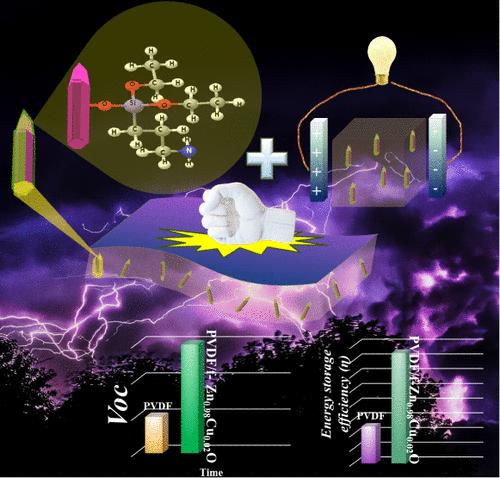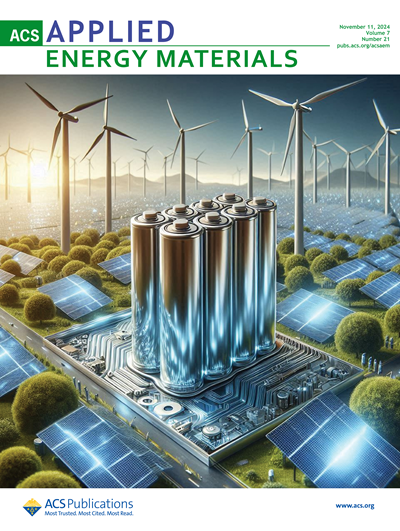功能化铜掺杂 ZnO/PVDF 复合材料:用于可穿戴设备的卓越储能材料
IF 5.4
3区 材料科学
Q2 CHEMISTRY, PHYSICAL
引用次数: 0
摘要
人类健康和福祉是当前全球研究的重点。自供电智能可穿戴技术为改善人类生活带来了巨大希望。然而,开发为传感器、可穿戴设备和便携式电子设备供电的高储能材料仍具有挑战性。在此,我们报告了一种具有高储能和能量收集能力的复合材料 PVDF/f-Zn1-xCuxO(x = 0、0.01、0.02、0.03)的设计。该材料通过水热法合成,在氧化锌(ZnO)中掺入铜(Cu),然后用 3- 氨基丙基三乙氧基硅烷(APTES)进行胺官能化。有趣的是,掺杂了 2 wt % 铜的氧化锌在合成过程中从纳米片状形态转变为单轴纳米棒状形态,这是实现高能量存储特性的关键因素。APTES 的改性促进了单轴填料在聚合物基体中的分散。在聚偏二氟乙烯(PVDF)中加入 f-Zn0.98Cu0.02O,与纯 PVDF 相比,拉伸强度提高了 154%,杨氏模量提高了 56%。此外,PVDF/f-Zn0.98Cu0.02O 纳米复合材料表现出卓越的储能密度(9 J/cm3)和效率(81%)。此外,它还表现出令人印象深刻的压电响应,输出电压为 ∼ 12 V,功率密度约为 21.17 μW/cm2,明显高于纯 PVDF 和其他当代复合材料。通过各种生物力学压力应用(如手指敲击、手跺脚和手指弯曲)测试了该复合材料在可穿戴设备中的效率,结果表明其反应非常出色。本文章由计算机程序翻译,如有差异,请以英文原文为准。

Functionalized Cu-Doped ZnO/PVDF Composite: An Excellent Energy Storage Material for Wearable Devices
Human health and well-being are major focuses of current research worldwide. Self-powered smart wearable technology holds great promise for enhancing human life. However, developing materials with a high energy storage capacity for powering sensors, wearables, and portable electronics remains challenging. Here, we report on the design of a composite material, PVDF/f-Zn1–xCuxO (x = 0, 0.01, 0.02, 0.03), with high energy storage and energy- harvesting capacity. The material was synthesized via a hydrothermal process, in which copper (Cu) was doped into zinc oxide (ZnO) and then amine-functionalized with 3-aminopropyl triethoxysilane (APTES). Interestingly, the 2 wt % Cu-doped ZnO transformed from a nanoflake to a uniaxial nanorod morphology during synthesis, a key factor for high-energy storage properties. The modification of APTES facilitated the dispersion of uniaxial fillers within the polymer matrix. Adding f-Zn0.98Cu0.02O to polyvinylidene fluoride (PVDF) resulted in a 154% increase in tensile strength and a 56% increase in Young’s modulus compared with neat PVDF. Moreover, the PVDF/f-Zn0.98Cu0.02O nanocomposite exhibited excellent energy storage density (9 J/cm3) and efficiency (81%). Additionally, it demonstrated an impressive piezoresponse, with an output voltage of ∼12 V and a power density of approximately 21.17 μW/cm2, significantly higher than those of neat PVDF and other contemporary composites. The efficiency of the composite for wearable devices was tested through various biomechanical pressure applications such as finger tapping, hand stomping, and finger bending, and it showed outstanding responses.
求助全文
通过发布文献求助,成功后即可免费获取论文全文。
去求助
来源期刊

ACS Applied Energy Materials
Materials Science-Materials Chemistry
CiteScore
10.30
自引率
6.20%
发文量
1368
期刊介绍:
ACS Applied Energy Materials is an interdisciplinary journal publishing original research covering all aspects of materials, engineering, chemistry, physics and biology relevant to energy conversion and storage. The journal is devoted to reports of new and original experimental and theoretical research of an applied nature that integrate knowledge in the areas of materials, engineering, physics, bioscience, and chemistry into important energy applications.
 求助内容:
求助内容: 应助结果提醒方式:
应助结果提醒方式:


